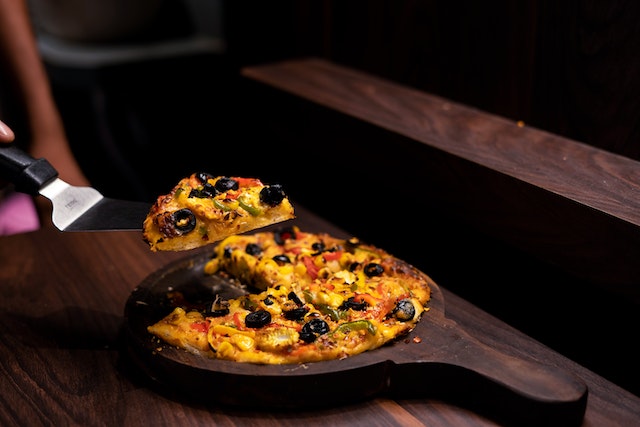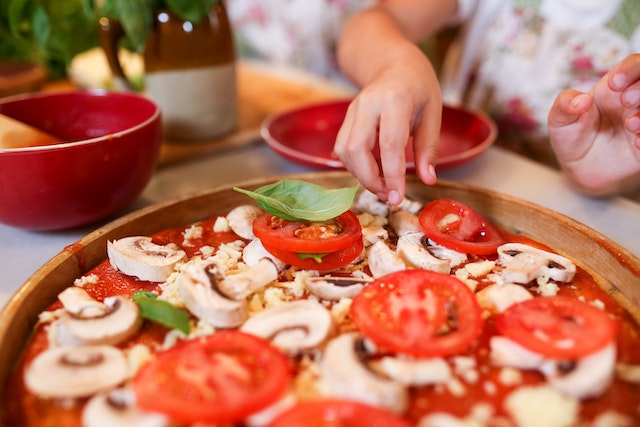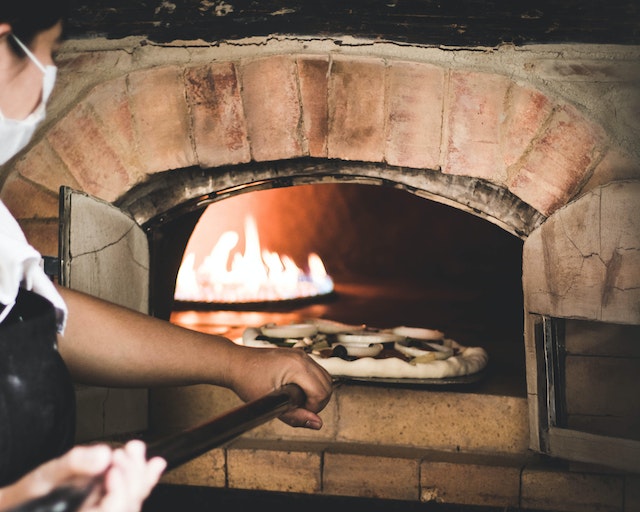Are you craving the perfect slice of pizza? Whether you’re a pizza aficionado or just getting your feet (and tastebuds) wet in the world of Italian cuisine, baking pizza is an art that requires skill and practice. One question many aspiring chefs ask is “How long should I bake my pizza?” The answer to this age-old query isn’t as straightforward as it may seem. With different types of pizzas requiring unique baking times, learning how to make delicious homemade pies takes some trial and error — plus a few helpful tips along the way.
How long to bake pizza? In this blog post, we’ll discuss ready-to-bake store bought pizzas as well as homemade varieties so you can master your oven game and enjoy a restaurant quality dish from the comfort of home!
The Essential Ingredients for Homemade Pizza
To make a homemade pizza, you will need the following essential ingredients:
– Pizza dough: You can either make your own pizza dough from scratch using flour, yeast, water, salt, and olive oil, or you can purchase pre-made pizza dough from a grocery store or local pizzeria.
– Pizza sauce: A good pizza sauce is made from crushed or pureed tomatoes, garlic, oregano, salt, and olive oil. You can also add other seasonings to taste.
– Cheese: The most common cheese used on pizza is mozzarella, but you can also use other varieties such as Parmesan, cheddar, or goat cheese.
– Toppings: This is where you can get creative and add your favorite toppings such as pepperoni, sausage, mushrooms, onions, peppers, olives, or any other toppings you prefer.
– Olive oil: A drizzle of olive oil on top of the pizza before baking can enhance the flavor and texture of the crust.
– Cornmeal or flour: Dusting your pizza peel or baking sheet with cornmeal or flour can prevent the dough from sticking and make it easier to transfer to the oven.
By having these essential ingredients on hand, you can make a delicious homemade pizza that is sure to please.

What Temperature Should You Bake Pizza At?
The ideal temperature for baking pizza depends on the type of oven you have. Here are some general guidelines:
– Conventional oven: Preheat your oven to 450-500°F (232-260°C) and place your pizza on a baking sheet or a preheated pizza stone. Bake for 12-15 minutes, or until the crust is golden brown and the cheese is melted and bubbly.
– Pizza oven: If you have a pizza oven, preheat it to 500-600°F (260-315°C) and cook the pizza for 5-7 minutes, or until the crust is crispy and the cheese is melted.
– Wood-fired oven: A wood-fired oven can reach temperatures of 800°F (427°C) or higher. Cook the pizza for 1-2 minutes, turning it frequently with a long-handled pizza peel to ensure even cooking.
Remember that baking time and temperature can vary depending on the thickness of your crust and the toppings you use. It’s important to keep an eye on your pizza while it’s baking and adjust the time and temperature as needed to achieve your desired level of crispiness and meltiness.
How Long Should You Bake Pizza For?
The baking time for pizza can vary depending on the thickness of the crust, the type of toppings, and the temperature of the oven. Here are some general guidelines:
– Conventional oven: Bake your pizza at 450-500°F (232-260°C) for 12-15 minutes, or until the crust is golden brown and the cheese is melted and bubbly.
– Pizza oven: Bake your pizza at 500-600°F (260-315°C) for 5-7 minutes, or until the crust is crispy and the cheese is melted.
– Wood-fired oven: Cook your pizza for 1-2 minutes in a wood-fired oven that can reach temperatures of 800°F (427°C) or higher, turning it frequently with a long-handled pizza peel to ensure even cooking.
It’s important to keep an eye on your pizza while it’s baking and adjust the time as needed to achieve your desired level of doneness. The crust should be golden brown and the cheese should be melted and bubbly. Use a pizza cutter or a sharp knife to slice your pizza and serve it hot.
Factors That Affect Baking Time Pizza
The baking time for pizza can vary based on several factors. Here are some of the main factors that can affect the baking time of a pizza:
– Thickness of the crust: A thicker crust will require a longer baking time than a thin crust.
– Type of toppings: Dense toppings like sausage or vegetables can add extra moisture to the pizza, which can increase the baking time.
– Oven temperature: A higher oven temperature will shorten the baking time, while a lower oven temperature will increase the baking time.
– Type of oven: Different types of ovens, such as conventional ovens, pizza ovens, and wood-fired ovens, can have different optimal baking times.
– Pizza size: The size of the pizza can also affect the baking time. A larger pizza will require a longer baking time than a smaller pizza.
– Pizza placement: Where you place the pizza in the oven can affect the baking time. Placing the pizza on the bottom rack of the oven can result in a longer baking time, while placing it on the top rack can result in a shorter baking time.
– Dough hydration: The hydration level of the dough can also affect the baking time. A dough with higher hydration will have a shorter baking time than a dough with lower hydration.
By considering these factors and adjusting the baking time accordingly, you can bake a perfect pizza every time.

Recommended Baking Time for Different Types of Pizza
The recommended baking time for different types of pizza can vary based on several factors such as oven type, crust thickness, and toppings. Here are some general guidelines:
– Margherita pizza: Bake at 450-500°F (232-260°C) for 10-12 minutes, or until the crust is golden brown and the cheese is melted.
– Pepperoni pizza: Bake at 450-500°F (232-260°C) for 12-15 minutes, or until the crust is golden brown and the cheese is melted and bubbly.
– Vegetable pizza: Bake at 450-500°F (232-260°C) for 12-15 minutes, or until the crust is golden brown and the vegetables are tender.
– Deep-dish pizza: Bake at 375-400°F (190-204°C) for 30-35 minutes, or until the crust is golden brown and the cheese is melted.
– Thin-crust pizza: Bake at 450-500°F (232-260°C) for 8-10 minutes, or until the crust is crispy and the cheese is melted.
Remember that these are general guidelines and the actual baking time can vary depending on the factors mentioned earlier. It’s important to keep an eye on your pizza while it’s baking and adjust the time as needed to achieve your desired level of doneness. When in doubt, refer to the recipe or instructions that came with your pizza dough or pre-made crust.
How Long Should I Preheat My Oven Before Baking A Pizza?
It’s important to preheat your oven before baking a pizza to ensure that the crust cooks evenly and becomes crispy. The recommended preheating time for an oven when baking pizza is typically around 15-20 minutes, but this can vary depending on your oven and the type of pizza you’re making. It’s always a good idea to check your recipe or pizza dough instructions to see if there are any specific preheating recommendations.
In general, you want to make sure that your oven has reached the desired temperature before putting your pizza in to bake. You can use an oven thermometer to confirm that the temperature has stabilized and is ready for your pizza.
How to Know When Your Pizza is Done?
Knowing when your pizza is done can be tricky, but there are a few signs to look for to ensure that your pizza is fully cooked and ready to eat:
– Check the crust: The crust should be golden brown and crispy. You can lift the edge of the pizza with a spatula or tongs to check the bottom of the crust to make sure it’s not undercooked or soggy.
– Look at the cheese: The cheese should be melted and bubbly. Check the center of the pizza to make sure the cheese is fully melted and not still in large clumps.
– Use a thermometer: If you’re using a homemade pizza dough, you can insert an instant-read thermometer into the thickest part of the crust to make sure it has reached an internal temperature of at least 190°F (88°C).
– Tap the crust: Give the crust a gentle tap with a fork or knife. If it sounds hollow, the crust is likely fully cooked.
– Slice and serve: Finally, slice the pizza and serve it hot. The toppings should be hot and fully cooked, and the crust should be crispy and flavorful.
Remember that baking time and temperature can vary depending on the type of oven, crust thickness, and toppings. It’s always better to check the pizza a few times during the baking process rather than risk overcooking or undercooking it. Enjoy your homemade pizza!
What Kind Of Pan Should I Use To Bake A Pizza?
The kind of pan you should use to bake a pizza depends on the type of crust you want and the method you prefer to use. Here are some options:
– Pizza stone: A pizza stone is a popular option for making crispy, restaurant-quality pizza at home. The stone absorbs moisture from the crust and distributes heat evenly, resulting in a crispy crust with a chewy interior.
– Baking sheet: A baking sheet is a versatile option for baking pizza, and it’s great for making thin crust pizza. Make sure to preheat the baking sheet before adding the pizza to help ensure a crispy crust.
– Cast iron skillet: A cast iron skillet can also be used to make pizza. Preheat the skillet in the oven before adding the dough, and then top the pizza with your favorite toppings and bake until the crust is golden brown.
– Deep dish pan: If you’re making a deep dish pizza, you’ll need a deep dish pan. These pans are typically made of metal or cast iron and have high sides to hold the deep dish crust and toppings.
– Pizza screen: A pizza screen is a flat mesh pan that allows heat to circulate evenly around the pizza. It’s great for making thin crust pizza and can be used in place of a baking sheet.
When choosing a pan, consider the type of crust you want and the oven you’ll be using. Make sure the pan is large enough to hold your pizza and sturdy enough to handle the weight of the toppings. With the right pan and a few simple ingredients, you can make delicious homemade pizza right in your own kitchen.

What Are Some Common Mistakes People Make When Baking Pizza?
Baking a pizza at home can be a fun and delicious experience, but there are some common mistakes that people make. Here are a few to avoid:
– Overloading the pizza with toppings: Adding too many toppings can weigh down the pizza and prevent it from cooking evenly. Stick to a few key toppings and distribute them evenly.
– Not preheating the oven: Preheating the oven is crucial for achieving a crispy crust. Make sure to preheat the oven for at least 15-20 minutes before baking the pizza.
– Using too much sauce: Using too much sauce can make the crust soggy and prevent it from cooking evenly. Use a light hand when applying the sauce.
– Undercooking or overcooking the pizza: Baking time can vary depending on the oven and the thickness of the crust. Check the pizza frequently during baking and adjust the time as needed.
– Using cold dough: Cold dough can prevent the pizza from cooking evenly and result in a tough crust. Make sure to let the dough come to room temperature before using it.
– Not using enough flour: Using too little flour can result in a sticky dough that’s difficult to work with. Use enough flour to prevent sticking and make it easier to shape the dough.
– Cutting the pizza too soon: Cutting the pizza too soon can cause the cheese and toppings to slide off. Let the pizza rest for a few minutes before slicing it.
By avoiding these common mistakes, you can make a delicious pizza at home that’s sure to impress.
>>> You might also like:
How Long to Bake Pizza at 400?
How To Cook Bagel Bites In Oven?
How Long Should Pizza Dough Proof at Room Temperature?
What Are Some Tips For Making The Perfect Pizza?
Here are some tips for making the perfect pizza at home:
– Use high-quality ingredients: The quality of your ingredients can make a big difference in the flavor of your pizza. Choose fresh, high-quality ingredients for the best results.
– Preheat the oven: Preheating the oven is key to achieving a crispy crust. Make sure to preheat the oven for at least 15-20 minutes before baking the pizza.
– Don’t overload the toppings: Adding too many toppings can weigh down the pizza and prevent it from cooking evenly. Stick to a few key toppings and distribute them evenly.
– Use a pizza stone or baking steel: Using a pizza stone or baking steel can help create a crispy crust and evenly cooked pizza.
– Stretch the dough properly: Properly stretching the dough can help create a thin and crispy crust. Gently stretch the dough by hand or use a rolling pin, making sure not to overwork the dough.
– Use a light hand with the sauce: Using too much sauce can make the crust soggy and prevent it from cooking evenly. Use a light hand when applying the sauce.
– Bake the pizza on the lowest oven rack: Baking the pizza on the lowest oven rack can help create a crispy crust by exposing it to direct heat.
– Let the pizza rest before slicing: Letting the pizza rest for a few minutes before slicing can help prevent the toppings from sliding off and make it easier to slice.
By following these tips, you can make a delicious and satisfying pizza at home. Don’t be afraid to experiment with different toppings and crusts to find your perfect pizza.
Can I Bake A Frozen Pizza?
Yes, you can bake a frozen pizza, but there are a few things to keep in mind.
First, it’s important to follow the instructions on the packaging, as cooking times and temperatures may vary depending on the brand and type of frozen pizza.
In general, most frozen pizzas can be baked directly from the freezer, without thawing. Preheat your oven to the recommended temperature on the packaging and place the frozen pizza directly on the oven rack or on a baking sheet.
It’s also a good idea to check the pizza periodically while it’s cooking, as the cooking time may need to be adjusted based on your oven and the size of the pizza.
Keep in mind that baking a frozen pizza may result in a slightly softer crust than if you were to bake a fresh pizza, but it can still be delicious and convenient for a quick meal or snack.
>>> See more: The Best Homemade Pizza You’ll Ever Eat
Conclusion: Ultimately, the length of time it takes to bake a pizza depends on the type of pizza you choose, as well as the size and type of oven being used. The temperature, time and specifics for any recipe should always be followed, but in general, pizzas baked in a regular oven at 350°F (175°C) will usually take approximately 15-20 mins to fully cook. Beyond this, it’s simply a matter of practice and trial-and-error until you find that perfect baking time that best suits your tastebuds.
Don’t be afraid to experiment! With each attempt, you can learn more and all nuances of baking delicious homemade pizza at home. So why not get your hands on some ingredients now and give making your own pizzas a go? Go ahead and try out different baking times until you find what works best for you – everyone has their own unique preference when it comes to how long they choose to bake their pizzas. Just remember “the golden rule” – How Long To Bake Pizza?
Come read the latest news and updates from Village Pizza in Nags Head! We’ll keep you posted on all the delicious happenings at our pizzeria!

